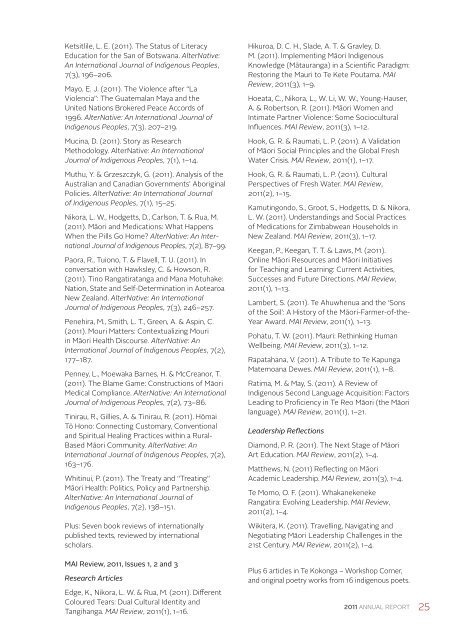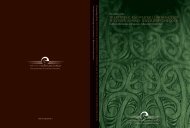ANNUAL REPORT - NgÄ Pae o te MÄramatanga
ANNUAL REPORT - NgÄ Pae o te MÄramatanga
ANNUAL REPORT - NgÄ Pae o te MÄramatanga
You also want an ePaper? Increase the reach of your titles
YUMPU automatically turns print PDFs into web optimized ePapers that Google loves.
Ketsitlile, L. E. (2011). The Status of Li<strong>te</strong>racyEducation for the San of Botswana. Al<strong>te</strong>rNative:An In<strong>te</strong>rnational Journal of Indigenous Peoples,7(3), 196–206.Mayo, E. J. (2011). The Violence af<strong>te</strong>r “LaViolencia”: The Gua<strong>te</strong>malan Maya and theUni<strong>te</strong>d Nations Brokered Peace Accords of1996. Al<strong>te</strong>rNative: An In<strong>te</strong>rnational Journal ofIndigenous Peoples, 7(3). 207–219.Mucina, D. (2011). Story as ResearchMethodology. Al<strong>te</strong>rNative: An In<strong>te</strong>rnationalJournal of Indigenous Peoples, 7(1), 1–14.Muthu, Y. & Grzeszczyk, G. (2011). Analysis of theAustralian and Canadian Governments’ AboriginalPolicies. Al<strong>te</strong>rNative: An In<strong>te</strong>rnational Journalof Indigenous Peoples, 7(1), 15–25.Nikora, L. W., Hodgetts, D., Carlson, T. & Rua, M.(2011). Māori and Medications: What HappensWhen the Pills Go Home? Al<strong>te</strong>rNative: An In<strong>te</strong>rnationalJournal of Indigenous Peoples, 7(2), 87–99.Paora, R., Tuiono, T. & Flavell, T. U. (2011). Inconversation with Hawksley, C. & Howson, R.(2011). Tino Rangatiratanga and Mana Motuhake:Nation, Sta<strong>te</strong> and Self-De<strong>te</strong>rmination in Ao<strong>te</strong>aroaNew Zealand. Al<strong>te</strong>rNative: An In<strong>te</strong>rnationalJournal of Indigenous Peoples, 7(3), 246–257.Penehira, M., Smith, L. T., Green, A. & Aspin, C.(2011). Mouri Mat<strong>te</strong>rs: Con<strong>te</strong>xtualizing Mouriin Māori Health Discourse. Al<strong>te</strong>rNative: AnIn<strong>te</strong>rnational Journal of Indigenous Peoples, 7(2),177–187.Penney, L., Moewaka Barnes, H. & McCreanor, T.(2011). The Blame Game: Constructions of MāoriMedical Compliance. Al<strong>te</strong>rNative: An In<strong>te</strong>rnationalJournal of Indigenous Peoples, 7(2), 73–86.Tinirau, R., Gillies, A. & Tinirau, R. (2011). HōmaiTō Hono: Connecting Customary, Conventionaland Spiritual Healing Practices within a Rural-Based Māori Community. Al<strong>te</strong>rNative: AnIn<strong>te</strong>rnational Journal of Indigenous Peoples, 7(2),163–176.Whitinui, P. (2011). The Treaty and “Treating”Māori Health: Politics, Policy and Partnership.Al<strong>te</strong>rNative: An In<strong>te</strong>rnational Journal ofIndigenous Peoples, 7(2), 138–151.Plus: Seven book reviews of in<strong>te</strong>rnationallypublished <strong>te</strong>xts, reviewed by in<strong>te</strong>rnationalscholars.MAI Review, 2011, Issues 1, 2 and 3Research ArticlesEdge, K., Nikora, L. W. & Rua, M. (2011). DifferentColoured Tears: Dual Cultural Identity andTangihanga. MAI Review, 2011(1), 1–16.Hikuroa, D. C. H., Slade, A. T. & Gravley, D.M. (2011). Implementing Māori IndigenousKnowledge (Mātauranga) in a scientific paradigm:Restoring the Mauri to Te Ke<strong>te</strong> Poutama. MAIReview, 2011(3), 1–9.Hoeata, C., Nikora, L., W. Li, W. W., Young-Hauser,A. & Robertson, R. (2011). Māori Women andIntima<strong>te</strong> Partner Violence: Some SocioculturalInfluences. MAI Review, 2011(3), 1–12.Hook, G. R. & Raumati, L. P. (2011). A Validationof Māori Social Principles and the Global FreshWa<strong>te</strong>r Crisis. MAI Review, 2011(1), 1–17.Hook, G. R. & Raumati, L. P. (2011). CulturalPerspectives of Fresh Wa<strong>te</strong>r. MAI Review,2011(2), 1–15.Kamutingondo, S., Groot, S., Hodgetts, D. & Nikora,L. W. (2011). Understandings and Social Practicesof Medications for Zimbabwean Households inNew Zealand. MAI Review, 2011(3), 1–17.Keegan, P., Keegan, T. T. & Laws, M. (2011).Online Māori Resources and Māori Initiativesfor Teaching and Learning: Current Activities,Successes and Future Directions. MAI Review,2011(1), 1–13.Lambert, S. (2011). Te Ahuwhenua and the ‘Sonsof the Soil’: A History of the Māori-Farmer-of-the-Year Award. MAI Review, 2011(1), 1–13.Pohatu, T. W. (2011). Mauri: Rethinking HumanWellbeing. MAI Review, 2011(3), 1–12.Rapatahana, V. (2011). A Tribu<strong>te</strong> to Te KapungaMa<strong>te</strong>moana Dewes. MAI Review, 2011(1), 1–8.Ratima, M. & May, S. (2011). A Review ofIndigenous Second Language Acquisition: FactorsLeading to Proficiency in Te Reo Māori (the Māorilanguage). MAI Review, 2011(1), 1–21.Leadership ReflectionsDiamond, P. R. (2011). The Next Stage of MāoriArt Education. MAI Review, 2011(2), 1–4.Matthews, N. (2011) Reflecting on MāoriAcademic Leadership. MAI Review, 2011(3), 1–4.Te Momo, O. F. (2011). WhakanekenekeRangatira: Evolving Leadership. MAI Review,2011(2), 1–4.Wiki<strong>te</strong>ra, K. (2011). Travelling, Navigating andNegotiating Māori Leadership Challenges in the21st Century. MAI Review, 2011(2), 1–4.Plus 6 articles in Te Kokonga – Workshop Corner,and original poetry works from 16 indigenous poets.2011 <strong>ANNUAL</strong> <strong>REPORT</strong> 25
















